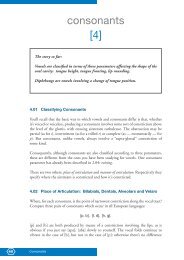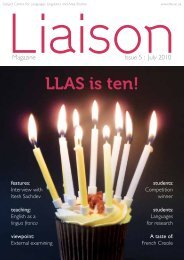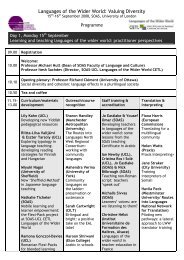PHONETICS MANUAL.indd - HumBox
PHONETICS MANUAL.indd - HumBox
PHONETICS MANUAL.indd - HumBox
You also want an ePaper? Increase the reach of your titles
YUMPU automatically turns print PDFs into web optimized ePapers that Google loves.
Here are some punctuation conventions which you should note:<br />
Capital letters and apostrophes are used only if some special IPA value is<br />
intended (as with [I] and [R] for example). So Tony Blair’s Britain would<br />
be transcribed [ten blz brtn], with lower-case throughout, and no<br />
apostrophe. Otherwise you can use the same punctuation and word<br />
spacing as the original. But it’s usually best to transcribe numbers and<br />
dates in full, and also initials like U.S.A. [ju.s.e]<br />
Broad and narrow transcription<br />
Some transcriptions provide less detail than others. In so-called “broad” transcriptions,<br />
differences between sounds are shown only if they can serve to distinguish words from<br />
one another in a particular language. For example, in English the difference between<br />
the [l] of look and the [r] of rook obviously has to be shown. However, “clear” and<br />
“dark” [l] (see 4.10) cannot distinguish words, as in English they don’t occur in the<br />
same place. An [l] at the beginning of a word is always clear (like), but at the end<br />
(well) only the dark variety [ɫ] occurs, so a pair of words [wɛl] and [wɛɫ] would not be<br />
possible. Accordingly in a broad transcription we write [lʊk] and [rʊk], differentiating<br />
[l] and [r], but [laik] and [wɛl], not differentiating between the two types of [l].<br />
Similarly with the longer and shorter variants of vowels (see Exercise 46). The vowels<br />
of bee and beat would be transcribed with [i] in both cases, even though in bee the<br />
vowel is appreciably longer than in beat (this is because beat ends in a consonant and<br />
bee doesn’t). A pair of words like [bi] and [biː] would not be possible in English. Nor,<br />
in a broad transcription, need it be specified that RP r is an approximant: replacing<br />
approximant [ɹ] by some other kind of r wouldn’t change the identity of the word rook,<br />
so [rʊk] is a sufficiently distinctive transcription.<br />
“Narrow” transcriptions, on the other hand, do include these less crucial differences.<br />
So well might indeed be transcribed as [w], bee as [bi], rook as [k], and so on.<br />
The more detail is included, the narrower the transcription becomes. When it is<br />
desired to specify which kind of transcription is involved — broad or narrow — the<br />
convention is to place broad transcriptions in slashes / /, reserving square brackets for<br />
narrow transcriptions. So rule could either be /rul/ (broad) or [u] (narrow). The<br />
following transcriptions of English are of the broad variety (although, as is customary,<br />
the reduction of unstressed vowels to [] is indicated — see below). Further examples<br />
of narrow transcription are given in 5.03 in connection with French, German and<br />
Spanish.<br />
A few other points now follow, relating particularly to features of English.<br />
Regional accents.<br />
Most regional variations are far too subtle to be picked up by the broad system of<br />
transcription being introduced here. However, there are one or two conspicuous<br />
Phonetic Transcription and General Revision<br />
65






